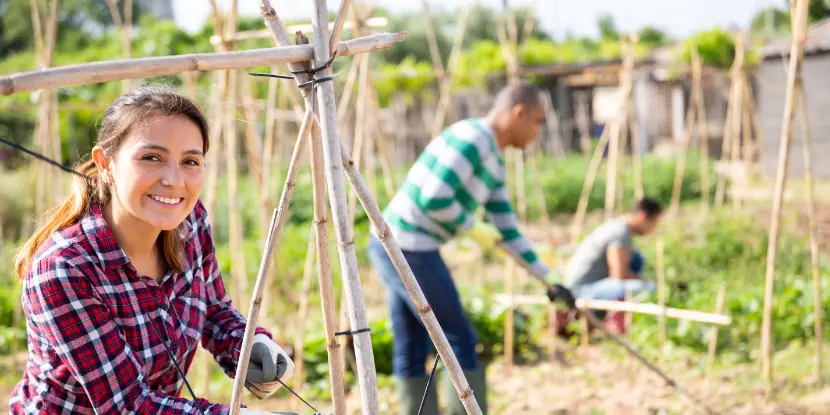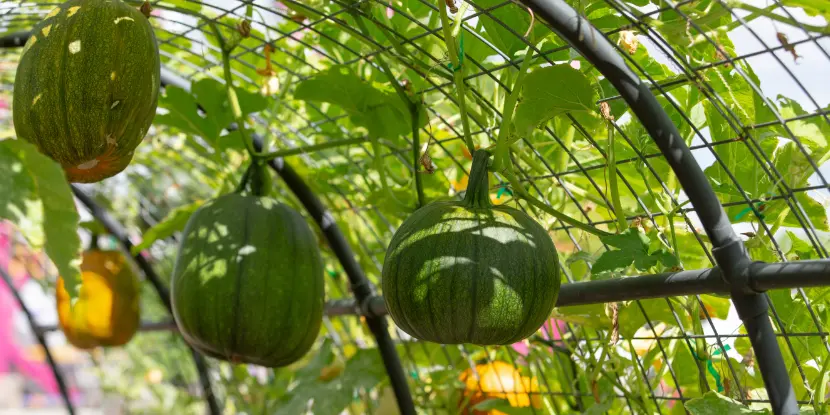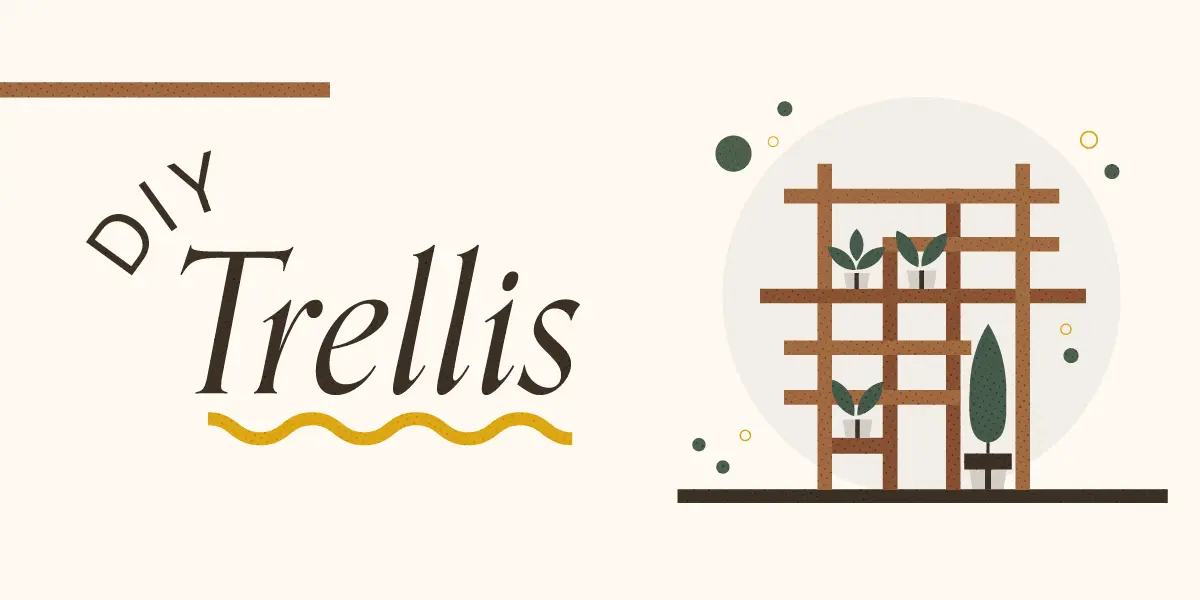Like people, some plants need more support than others.
Sure, they can manage without it, but problems arise with unsupported vines like peas and cantaloupe:
- They can break or bend under their weight.
- Their fruits and vegetables may rot from contact with soil.
- Limited air circulation can lead to disease.
- Vines can overwhelm and suppress other plants.
A trellis provides support for vining plants, training them upwards while promoting better health and increased yields.

A bamboo trellis with netting in a field.
Benefits of a Garden Trellis
- It saves space in small gardens.
- It improves air circulation around plants.
- It keeps fruits and vegetables off the ground.
- It lends visual interest and vertical dimension to the garden.
- It allows for easy harvesting and maintenance.
- It reduces the risk of disease.
- It encourages healthier, more vigorous plants.
Choosing a Trellis Design
The type of trellis you build will depend on available space, your preferences, and your garden’s plants. These are the most popular options:
- An A-frame trellis is ideal for small gardens and can be fashioned with two stakes or poles and twine.
- A teepee design is perfect for larger plants like beans and cucumbers that require more climbing space.
- A wall trellis takes advantage of vertical space and can be mounted against a wall or fence.
- A wire trellis is made of metal wires stretched between posts or a frame.
- An arch trellis is a decorative design that adds visual appeal to garden entryways and pathways.
- A cattle panel trellis is constructed from welded wire panels and can support even the heaviest vining plants like watermelons and squash.

Securing a teepee trellis made of bamboo.
Materials Needed
- Wooden stakes or poles (depending on the chosen design)
- Twine, wire, or netting
- Hammer
- Drill
- Nails, screws, hooks, and eyebolts (depending on the selected design)
- Hand saw or power saw (if cutting wood)
- Wire cutters (if using wire or netting)
- Measuring tape
Step-by-Step Instructions
A-Frame Trellis
- Start by cutting two wooden stakes or poles to your desired height.
- Place the two stakes in the garden, positioning them in an “A” shape. Make sure they’re secure in the ground.
- Lash the stakes together at the top with twine, wire, or netting.
- Add support by tying horizontal lines of twine, wire, or netting between the two stakes at intervals down the length of the trellis.
Teepee Trellis
- Cut three wooden stakes or poles to your desired height.
- Place the three stakes in the garden, positioning them in a teepee shape. Make sure they’re secure in the ground.
- Lash the stakes together at the top with twine, wire, or netting.
- Add support by tying horizontal lines of twine, wire, or netting between the three stakes at intervals down the length of the trellis.
Wall Trellis
- Measure the space you want to cover and cut several wooden stakes or poles to fit.
- Attach vertical stakes securely against a wall or fence.
- Lash horizontal lines of twine, wire, or netting between the stakes at intervals down the length of the trellis.

Grape vines climbing an all-wood wall trellis.
Wire Trellis
- Common materials include galvanized steel wire or stainless steel cable, eye hooks or turnbuckles, wall anchors or posts, and a drill.
- If wall-mounted: mark anchor points in a grid or linear pattern and drill holes for eye bolts or hooks.
- For freestanding trellises: dig holes and set sturdy posts in concrete or compacted soil.
- Attach eye bolts or hooks. Secure anchors into the drilled holes or posts at evenly spaced intervals.
- Run the wire through the eye bolts or hooks to form your chosen design.
- Use turnbuckles to tighten the wire so it’s taut but not strained.
- Wrap the wire securely, fasten with wire clamps if needed, and cut off excess wire
Training Your Vines to Climb a Trellis
- Plant your vines directly at the base of the trellis, spacing them appropriately to provide room for growth.
- Gently guide growing vines towards the trellis. To give the young stems a starting direction, you may need to tie them loosely to the trellis with garden ties or soft string.
- Check your vines regularly and continue to guide the new growth onto the trellis. Use your hands to guide tendrils and stems to wrap around the trellis.
- When training the delicate vines, be careful not to damage them. Handle them gently and avoid tying them too tightly, which can restrict growth and cause damage.
- Prune any excess growth that isn’t climbing the trellis or looks overcrowded. This directs the plant’s energy toward climbing and producing fruit or flowers.
- Inspect the garden ties periodically and adjust them as the vines thicken. Replace any ties that constrict the vines.
- For certain plants like tomatoes, you may need to weave horizontal branches into the trellis to ensure they are well-supported and don’t break under their weight.
- Apply mulch around the base of the plants to retain moisture and regulate soil temperature. Ensure the vines receive adequate water, especially during dry periods, to support vigorous growth.
- Look for common pests and diseases that can affect climbing plants. Early detection and treatment can prevent significant damage and maintain healthy growth.

Pumpkins handing from metal arched trellis.
FAQs: Answering Your Questions about Garden Trellises
Q: Do I need special tools or skills to build a garden trellis?
Building a simple garden trellis requires only simple tools like a hammer, saw, drill, and basic DIY skills. It’s an excellent project for beginners!
Q: Can I use a garden trellis for plants other than peas?
Absolutely! You can use your garden trellis for various vining plants, including beans, cucumbers, tomatoes, and flowers like morning glories or sweet peas.
Q: How tall should my garden trellis be?
That will depend on your plant’s needs and the available space in your garden. Generally, aim for a height of at least 6 feet to accommodate most vining crops.
Q: How far apart should I space the vertical stakes of my trellis?
Vertical stakes should be spaced 1 to 2 feet apart along the length of the trellis. This provides adequate support for climbing plants while allowing proper air circulation.
Q: Can I use recycled materials to build a trellis?
To create a sustainable garden trellis, you can repurpose old ladders, wire fencing, or even pallets. The materials should be sturdy enough to support the weight of your plants.
Q: Can I reuse my garden trellis in future growing seasons?
Yes, with proper maintenance, your garden trellis can last several years and be reused season after season.
Q: How should I secure my trellis in the ground?
Drive the stakes or poles about 12 inches into the ground. You can use anchors or concrete footings for added stability, especially for larger or heavier trellis designs.
Q: What types of plants are best suited for an arch trellis?
An arch trellis is best suited for lightweight, climbing plants that can easily wind around the structure. Plants like sweet peas, clematis, and morning glories are excellent choices, as they offer beautiful blooms and can easily cover the arch.
Q: How can I winterize my garden trellis?
Remove all plant material and debris. Inspect the trellis for any damage and make necessary repairs. If your trellis is made of wood, consider applying a weatherproof sealant. Store removable parts indoors or cover the trellis with a tarp to protect it from harsh winter conditions.
Q: Can I paint or stain my wooden trellis?
Yes, you can paint or stain your wooden trellis to match your garden aesthetics or protect it against the elements. Use exterior-grade paint or stain and ensure the wood is clean and dry before application.

